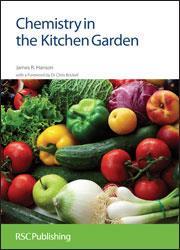Chemistry in the kitchen garden
Chemistry in the kitchen garden
James Hanson
RSC Publishing
2011 | 300pp | ?24.99 (HB)
ISBN 9781849733236
Reviewed by Phillip Broadwith

The resurgence in popularity of growing our own food provides the chemist-gardener with a number of interesting queries. Is there any chemical basis for the folklore advice of planting chrysanthemums or spring onions with your carrots to deter carrot root fly? What makes my onions taste mild one year and viciously pungent the next? Why are some varieties of vegetable more susceptible or resistant to diseases?
This book attempts to provide an insight into these and other intriguing aspects of the chemistry of edible plants - how the molecules they produce change at different stages of growth and ripening; how they react to environmental stresses like drought, disease or attack by herbivores; and how different families of fruit and vegetables deal with these changes in different ways.
There is a general introduction that covers the families of natural products, their biosynthesis and their physiological actions, followed by individual chapters addressing the nuances of families of plants such as roots, brassicas, legumes, fruit and herbs. Similarities and differences in the types of molecules produced by different families or members within families are pointed out, while highlighting the complex and fascinating interplay of environmental factors in overall plant chemistry.
The book is, however, very firmly aimed at readers with a working knowledge of organic chemistry. It is written and laid out in a style that will be familiar to readers of academic journals, with structures numbered and cross-referenced throughout the text. It is unfortunate that these structures are drawn in an inconsistent and often untidy way, which detracts from the aesthetic appeal and becomes a distraction. A more general reader may find the book a little dry and difficult to follow, although it does have a comprehensive glossary and index.
Overall the book is interesting to read, and contains nuggets that will please and inspire the chemist-gardener. It would also provide a useful introductory reference text for anyone embarking on study in the field, but as recreational reading it is a challenge.
RSC members can purchase this book direct from the RSC for a 35% discount.












No comments yet